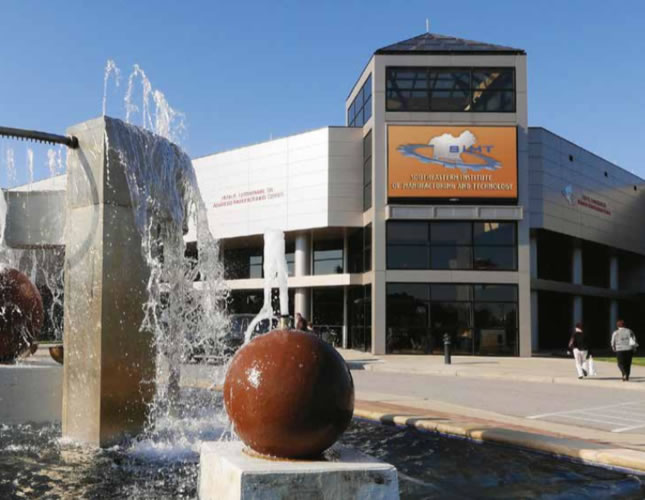
The Southeastern Institute of Manufacturing and Technology is associated with Florence-Darlington Technical College.
S.C. Encyclopedia | Technical education in South Carolina has a lengthy history, dating back to John de la Howe’s 1797 bequest of land to a school that would provide practical instruction for the needy children of Abbeville District. Systematic technical education, however, would have to wait until the post–World War II era, when political leaders realized that South Carolina’s ability to attract new industry hinged on the availability of an educated workforce.
The South Carolina technical education system was founded at a time when the economic outlook of South Carolina was depressed. Farm employment opportunities were rapidly diminishing, and the state was faced with an underskilled labor force and no adequate means of training them for the rapidly changing job market. The idea for a technical education system began with Governor Ernest F. Hollings. Hollings appointed a joint legislative study committee of three senators and three representatives under the chairmanship of state senator John C. West. Known as the West Committee, the committee’s purpose was to develop a training system that would attract new and diversified industry to the state. After careful study, the West Committee recommended a “crash” program to provide immediate training for established industries and a technical training program to train high school graduates for initial employment as technicians in industry. The first step the South Carolina General Assembly took to initiate a technical education system was to establish the Advisory Committee for Technical Training in May 1961.
The short-term training program became known as Special Schools (renamed the Center for Accelerated Technology Training in 2001). The Special Schools program worked in coordination with the South Carolina Development Board. After an industry indicated that it would locate in South Carolina, Special Schools staff determined training needs and recruited and trained potential employees. After the Special Schools training program was implemented, the Advisory Committee established permanent regional technical education centers. Greenville County was the first to apply for a technical center in September 1961, and the center opened the following year. Sixteen centers were established from that time until 1972, insuring that ninety-five percent of the state’s population was within a twenty-five-mile commuting distance of the nearest center.
In 1972, seven of the centers were authorized to offer college transfer associate degrees. Upon accreditation by the Southern Association of Colleges and Schools (SACS), technical education centers became two-year comprehensive community colleges known as technical colleges. By 1990 the remaining nine centers were also authorized to offer college transfer associate degrees.
Throughout the closing decades of the twentieth century, the technical colleges continued to pursue innovative means of educating South Carolinians. In 1981, the technical colleges began developing closer relationships with local high schools to prepare students for technical careers. Several universities and colleges collaborated with Greenville Technical College to create the University Center of Greenville and allow Greenville-area residents to take advantage of the resources of each school. A similar center was later established in Hilton Head. In 1988, Greenville Technical College broke ground on a new facility that would allow instruction to be offered via satellite. Classes were also taught via videocassette. With the advent of the Internet, technical college courses were offered on-line as well.
In 2004, 16 technical colleges still served the state. The colleges enrolled 230,485 South Carolinians in all programs in 2003. Sixty-four percent of the students were women in 2003, and thirty-eight percent of all students were minority students. [In 2016, the system served more than 260,000 students in credit and non-credit program. Some 58 percent of all South Carolinians enrolled as undergraduates in the state’s public higher education system attended one of the 16 tech colleges. Learn more.]
Technical colleges continue to provide learning opportunities that promote the economic and human resource development of the state. The technical education system has played a significant role in transforming a workforce formerly based in agriculture and textiles into a skilled workforce for highly diversified industries.
– Excerpted from the entry by Gemma K. Frock. To read more about this or 2,000 other entries about South Carolina, check out The South Carolina Encyclopedia by USC Press. (Information used by permission.)



 We Can Do Better, South Carolina!
We Can Do Better, South Carolina!
























